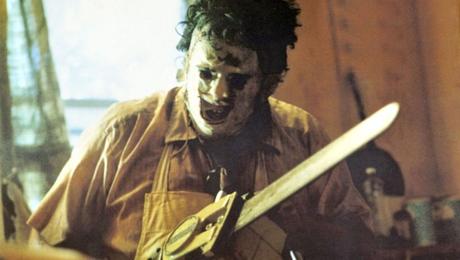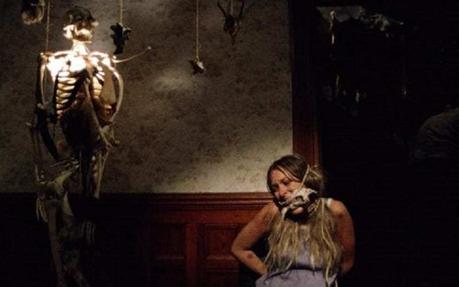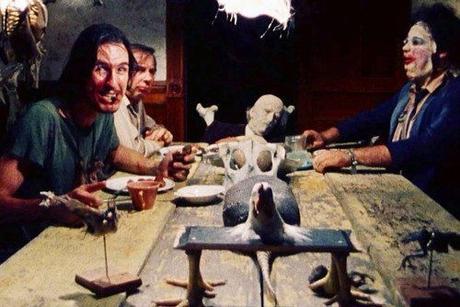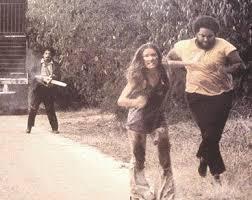Retro Review: 'The Texas Chainsaw Massacre'

In a small Wisconsin town in the 1950's a seemingly simple handyman named , was discovered to be a serial killer, grave robber, and cannibal earning him the infamous nickname, the Plainfield Ghoul. The gruesome and outrageous nature of his crimes have naturally inspired a number of famous horror movies and books. In the 1970's aspiring filmmaker Tobe Hooper wanted to make a film inspired by Gein, but he wanted to frame it within the context of the contemporary political and social zeitgeist at the time. The end result was a 1974 film from he and his writing partner Kim Henkel, which changed the horror genre forever, the Texas Chainsaw Massacre. With a tiny budget and a handful of people, he created a flick which provided nightmares for generations of viewers.
A group of teens head down to rural Texas to deal with an issue with a disturbed family cemetery plot. Along the way they pick up a deranged hitchhiker thus sealing their fate. This leads to them crossing paths with a family of cannibals in a desolate house and the dangerous son of this clan, Leatherface. One by one these teenagers are hunted down by the brutish man armed with a chainsaw until only one girl, Sally, is left. In order to survive she must not only avoid Leatherface by endure the rest of the lunatics in the Sawyer family.

One of the biggest draws of the Texas Chainsaw Massacre was Tobe Hooper's idea to promote the film as being based on true events. He even had a young John Larroquette to read a prologue to drive home the reality of what is about to happen. Aside from taking inspiration from the before-mentioned Ed Gein, none of the events of the film ever took place. However, as Hooper saw it, in order to push their agenda in Vietnam the government had no problem lying about the Gulf of Tonkin incident, the My Lai Massacre, and other events, so he too had every right to be dishonest to push his agenda. A clever "up yours" to a government which had no problem sending it's young people to suffer horrible deaths under false pretenses. Many have observed this is not the only influence the ever present violence of the era had on Hooper while making this film. The overall tone of Texas Chainsaw is visceral and chaotic to the point of almost being disorienting mirroring the violence in the real world, which had become all too commonplace. In the end, the final girl, Sally, is covered in blood and traumatized, but the fact that she simply survived where none of her friends did should absolutely be considered a victory. Hammering this home is the incredibly raw and realistic performance Marilyn Burns gave which deserves far more credit that it receives. The audience is so wrapped up in the horrors before them most do not even notice the lack of actual bloodshed in the film.
The bleak cynicism of what the country had become in the 70's had found its way into Tobe Hooper's film. There was a time when the desert planes of Texas was home to larger than life heroes and legends, but what we find there now is a desolate wasteland. This is a hellscape filled with blood, bones, and dirt with an isolated nightmare-filled house at the center of this world. From the way Leatherface's flesh eating family talk, this region used to have a thriving meat packaging industry which they were apart of. Now, like many businesses, the economic downturns of the era brutally torn away and the Sawyer family are the scars which remain. This clan of broken lunatics fit perfectly against the scorching and unforgiving Texas desert. These characters are so over-the-top from a crazed hitchhiker to an almost mummified grandfather that it brings a level of dark humor to the film.

While social commentary is nice and all, let us not kid ourselves that the driving factor in the film's landmark status was it's iconic villain Leatherface. Like all great movie monsters the audience was only given the information about him necessary to keep him scary and to move the plot along. There is no doubt this chainsaw-wielding psycho has a whole psychology textbook full of problems, which would naturally arise from being a cannibalistic butcher who wears the faces of his victims. But an outright mental dissection of what makes him tick would only take away the fear factor. From the moment he emerges smashing a poor soul's head in with a hammer we know he has no problem with acts of horrendous violence. Even a poor man bound to a wheelchair is not safe from his chainsaw. While on the surface he is nothing more than a brutal killing machine, and the movie could have gotten away with simply leaving it at that, but there is definitely more going. Despite being an unstoppable juggernaut compared to the rest of his frail and aging family, they have no problem pushing him around like a child. When it becomes clear that teenagers from the outside world are invading his space, Leatherface genuinely seems distressed and anxious about it rather than relishing the thought of bringing out the saw. Actor Gunnar Hansen initially turned the role down, but we are glad he eventually accepted it, because his performance was hugely important in bringing this character to life. His imposing physicality was amplified by lifts he wore in his shoes and the fact he only had one costume provided the grimy and tattered look of the character. Hansen even took it upon himself to spend time at a hospital for the mentally disturbed to learn their mannerisms and mindsets in order to bring those to his character. As far as he was concerned Leatherface was merely defending his home from these encroaching teenagers and if you can justify what your villain is doing it makes them that much scarier.

The and 1970's saw horror movies change forever. No longer was it being driven by the stars in front of the camera, but by the auteurs behind it with their macabre perspectives on society. Filmmakers like: George Romero, Herschell Gordon Lewis, and Wes Craven were changing scary films forever and Tobe Hooper stands right alongside them during this movement. The Texas Chainsaw Massacre rose above a simple low budget exploitation flick and became a powerful piece of cinema. As far as many were concerned it completed the evolution which the genre was going through at this time. Understandably it became one of the flagship films of the British "video nasties" due to it's brutality and violence. Like any successful slasher film, TCM has seen a number of , remakes, and over the years. Aside from the Texas Chainsaw Massacre 2 achieving cult classic status thanks to it's campy humor none of the other films have ever really landed. This film truly was lightning in a bottle and the elements which made the Texas Chainsaw Massacre such an important film may never be duplicated.

